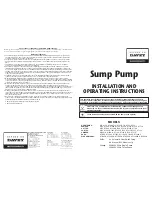
20
5.9. General information about SF
6
gas-insulated switching and
isolating apparatus
In its pure state, SF6 is an odourless, colourless, non-toxic
gas with a density about six times higher than that of air.
This is why, although it is free from any specific physiological
effects, it can produce the same effects as lack of oxygen in
places saturated with SF
6
.
The electric arc produced during the breaking phase of the
line-side isolator decomposes a very small amount of SF6.
The decomposition products remain inside the enclosure. The
probability of coming into contact with SF6 is extremely low
and even small quantities in the environment (1-3 ppm) are
immediately evident owing to its unpleasant, pungent odour.
Rooms must be ventilated before anyone enters them (see
standard IEC 1634).
Mechanical and electrical locks are used in the
compartments. The mechanical locks include:
– prevention locks
– safety locks (padlocks/keys).
The electric locks feature microswitches that ensure continuity
of service or make or break an electrical circuit.
5.11.1. Interlock between switch-disconnector and
earthing switch.
This is a mechanical prevention lock, which stops the
operating lever from being inserted into the corresponding
lever seat if the conditions are not correct.
The earthing switch can only be closed if the switch-
disconnector is open.
The switch-disconnector can only be closed if the earthing
switch is open.
5.11.2. Interlock between the operating lever of the
switch-disconnector and the motor
This is an electrical lock that prevents the motor from
functioning when the operating lever is in the seat of the IMS.
Insertion of the operating lever acts on a microswitch which
cuts off the power supplied to the motor and prevents it from
operating.
5.11.3. Interlock between the operating lever of the
earthing switch and the motor
This is an electrical lock that prevents the motor from
functioning when the blades of the earthing switch are closed
or the operating lever is in the seat of the ST.
A microswitch enables motor operation when the blades
of the earthing switch are open and the operating lever is
withdrawn from its seat.
5.10. Reference Standards
IEC EN 60447
Man-Machine Interface. Actuating principles.
IEC 447
Direction of movement of electrical apparatus
actuators.
CEI 17-4
Isolators and earthing switches for voltages over 1 kV
IEC 129
Isolators and earthing switches for voltages over 1 kV
IEC EN 60529
Protection classes of enclosures. Classification.
IEC 529
Protection classes of enclosures.
Classification.
CEI 17-9:1-2
Switch-disconnectors.
IEC 265-1-2
Switch-disconnectors.
IEC 1634
High voltage switchgear and controlgear. Use and
handling of sulphur hexafluoride (SF6) in high voltage
switchgear and controlgear.
CEI 11-35
Guideline to the execution of electrical substations for
the final customer/user.
IEC 62271-1
High-voltage switchgear and controlgear
- Part 1: common specification
IEC 62271-102
High-voltage switchgear and controlgear
- Part 102: Alternating current disconnectors and
earthing switches.
IEC 62271-103
High-voltage switchgear and controlgear
- Part 103: Switches for rated voltages above 1 kV
up to and including 52 kV
IEC 62271-105
High-voltage switchgear and controlgear
- Part 105: Alternating current switch-fuse
combinations.
CEI EN 60447
Man-machine interface. Switching principles.
IEC 447
Direction of movement of the electrical apparatus
actuators.
CEI 17-4
Isolators and earthing switches for voltages over 1 kV.
IEC 129
Isolators and earthing switches for voltages over 1 kV.
CEI EN 60529
Degrees of protection of the enclosures. Classification.
IEC 529
Degrees of protection of the enclosures.
Classification.
CEI 17-9/1-2
Switch-disconnectors.
IEC 265-1-2
Switch-disconnectors.
CEI EN 60694
Common specifications for high voltage switchgear and
controlgear.
IEC 694
Common specifications for high voltage switchgear and
controlgear standards.
IEC 1634
High-voltage switchgear and controlgear. Use and
handling of sulphur hexafluoride (SF6) in high voltage
switchgear and controlgear.
CEI 11-35
Guideline to the execution of electrical substations for
the final customer/user.
The operations must be performed with the
normal actuating torque using the dedicated
operating lever (
≤
100 Nm).
If the operations are obstructed, do not force
the mechanical interlocks but check that the
operating sequence is correct.
5.11. Interlocks
Содержание GSec/IB
Страница 43: ...43 ...
















































